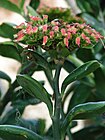Note: This is a project under development. The articles on this wiki are just being initiated and broadly incomplete. You can Help creating new pages.
Difference between revisions of "Pedilanthus tithymaloides"
| (One intermediate revision by the same user not shown) | |||
| Line 1: | Line 1: | ||
[[File:Starr 070302-5071 Pedilanthus tithymaloides.jpg|thumb|right|'''Pedilanthus tithymaloides''']] | [[File:Starr 070302-5071 Pedilanthus tithymaloides.jpg|thumb|right|'''Pedilanthus tithymaloides''']] | ||
| − | '''Euphorbia tithymaloides''' is a perennial succulent spurge. | + | '''Euphorbia tithymaloides''' is a perennial succulent spurge. It is an erect shrub, the plant is also known by the scientific name Pedilanthus tithymaloides. However, the genus Pedilanthus has been submerged into the genus Euphorbia, and is more correctly known by its new name. |
==Uses== | ==Uses== | ||
| − | {{Uses| | + | {{Uses|Skin problems}}. |
==Parts Used== | ==Parts Used== | ||
| Line 8: | Line 8: | ||
==Chemical Composition== | ==Chemical Composition== | ||
| − | Leaves samples were processed to obtain extracts using hexane (Hex), ethyl acetate (EA) and ethanol | + | Leaves samples were processed to obtain extracts using hexane (Hex), ethyl acetate (EA) and ethanol by maceration.<ref name="chemical composition"/> |
| − | <ref name="chemical composition"/> | ||
==Common names== | ==Common names== | ||
| − | {{Common names|kn=|ml=|sa=|ta=|te=|hi=|en=Devil's Backbone, Japanese Poinsettia | + | {{Common names|kn=|ml=|sa=|ta=|te=|hi=|en=Devil's Backbone, Japanese Poinsettia}} |
==Properties== | ==Properties== | ||
| Line 35: | Line 34: | ||
==Identification== | ==Identification== | ||
===Leaf=== | ===Leaf=== | ||
| − | {{Leaf|Simple|Acuminate in shape, With entire (smooth) edges | + | {{Leaf|Simple|Acuminate in shape, With entire (smooth) edges|The leaf is a simple angiosperm leaf, arranged oppositely on the stem. Each leaf is sessile and about 1.4 to 3 inches in length}}<ref name="Leaf"/> |
===Flower=== | ===Flower=== | ||
| − | {{Flower|Bisexual|Ovoid in shape|Pink||The seed pod is about 0.30 inches (7.6 mm) long and 0.35 inches (8.9 mm) wide, and ovoid in shape (with truncated ends) | + | {{Flower|Bisexual|Ovoid in shape|Pink||The seed pod is about 0.30 inches (7.6 mm) long and 0.35 inches (8.9 mm) wide, and ovoid in shape (with truncated ends)}} |
===Other features=== | ===Other features=== | ||
| Line 48: | Line 47: | ||
==How to plant/cultivate== | ==How to plant/cultivate== | ||
| − | Pedilanthus tithymaloides houseplant likes bright indirect sunlight. Plant in direct sun in fall and winter, but give it a little protection from stinging hot rays in spring and summer | + | Pedilanthus tithymaloides houseplant likes bright indirect sunlight. Plant in direct sun in fall and winter, but give it a little protection from stinging hot rays in spring and summer. |
| − | + | <<ref name="How to plant/cultivate"/> | |
| − | |||
| − | <ref name="How to plant/cultivate"/> | ||
==Commonly seen growing in areas== | ==Commonly seen growing in areas== | ||
| Line 74: | Line 71: | ||
==External Links== | ==External Links== | ||
| − | * [https://plants.usda.gov/core/profile?symbol=PETI Pedilanthus tithymaloides] | + | * [https://plants.usda.gov/core/profile?symbol=PETI Pedilanthus tithymaloides on plants.usda.govt] |
[[Category:Herbs]] | [[Category:Herbs]] | ||
[[Category:Euphorbiaceae]] | [[Category:Euphorbiaceae]] | ||
Latest revision as of 15:40, 29 June 2020
Euphorbia tithymaloides is a perennial succulent spurge. It is an erect shrub, the plant is also known by the scientific name Pedilanthus tithymaloides. However, the genus Pedilanthus has been submerged into the genus Euphorbia, and is more correctly known by its new name.
Contents
- 1 Uses
- 2 Parts Used
- 3 Chemical Composition
- 4 Common names
- 5 Properties
- 6 Habit
- 7 Identification
- 8 List of Ayurvedic medicine in which the herb is used
- 9 Where to get the saplings
- 10 Mode of Propagation
- 11 How to plant/cultivate
- 12 Commonly seen growing in areas
- 13 Photo Gallery
- 14 References
- 15 External Links
Uses
Parts Used
Chemical Composition
Leaves samples were processed to obtain extracts using hexane (Hex), ethyl acetate (EA) and ethanol by maceration.[1]
Common names
| Language | Common name |
|---|---|
| Kannada | |
| Hindi | |
| Malayalam | |
| Tamil | |
| Telugu | |
| Marathi | NA |
| Gujarathi | NA |
| Punjabi | NA |
| Kashmiri | NA |
| Sanskrit | |
| English | Devil's Backbone, Japanese Poinsettia |
Properties
Reference: Dravya - Substance, Rasa - Taste, Guna - Qualities, Veerya - Potency, Vipaka - Post-digesion effect, Karma - Pharmacological activity, Prabhava - Therepeutics.
Dravya
Rasa
Guna
Veerya
Vipaka
Karma
Prabhava
Habit
Identification
Leaf
| Kind | Shape | Feature |
|---|---|---|
| Simple | Acuminate in shape, With entire (smooth) edges | The leaf is a simple angiosperm leaf, arranged oppositely on the stem. Each leaf is sessile and about 1.4 to 3 inches in length |
Flower
| Type | Size | Color and composition | Stamen | More information |
|---|---|---|---|---|
| Bisexual | Ovoid in shape | Pink | The seed pod is about 0.30 inches (7.6 mm) long and 0.35 inches (8.9 mm) wide, and ovoid in shape (with truncated ends) |
Other features
List of Ayurvedic medicine in which the herb is used
Where to get the saplings
Mode of Propagation
How to plant/cultivate
Pedilanthus tithymaloides houseplant likes bright indirect sunlight. Plant in direct sun in fall and winter, but give it a little protection from stinging hot rays in spring and summer. <[3]



